| In this part, we will continue to study the orientation of ancient temples in Africa. |
|
Abusir el Melek is a modern Arab village was named after the royal necropolis in vicinities of ancient Memphis in a few kilometers to the North of the necropolis Saqqara. In the days of Pliny the Elder city Busiris famous for its catacombs. In Abusir survived 14 step pyramids of the 5th Dynasty, which are smaller by size and made with less quality than pyramids of previous 4th Dynasty. Most likely, the pharaohs of the 5th dynasty moved the main royal necropolis to Abusir, being unable to compete with monuments of their predecessors in Giza.
Diagonal of one the temples, next to the pyramid corresponds to the azimuth of 50 degrees.
|
|
In the area of Abu Ghurab there are the ruins of a large solar temple built by Pharaoh Nyuserre. Nyuserre’s temple rose on the plateau, raised above the valley due to the enormous stone- construction works. To an artificial platform led from the valley a road, which due to the location of the area approached to the construction at an angle. At the bottom there were monumental gates, built of limestone and faced with it.
Diagonal of the temple is close to the azimuth of pentagram - 54°. |
|
Ancient Hermopolis is located in the Middle Egypt. Modern Arabic name El Ashmuneyn comes from the Coptic Shmun, rising to the Egyptian Hmun - "eight", which means the eight local gods, or the Ogdoad.
The Greeks called this city Hermopolis, as they identified with their Hermes the chief God of the city - the God of Thoth. Nothing left from ancient Hermopolis. The city located on the west bank of Nile not far from the place where the channel of Bahr-el-Yusuf branches off to the West from the bed of Nile.
Orientation of the temple and the entire complex is close to the azimuth 75° and corresponds to hexagram. |
|
Temple of Gibis is well preserved Persian temple of ancient Egypt stands on volcanic rock. The temple, built at the turn of IV - V centuries BC during the invasion of the Persian conquerors, is dedicated to the gods Amun, Mutu and Khonsu, several additions to the temple were built before to Ptolemaic reign Egypt. Initially, the temple was built on the edge of the lake (long disappeared).
The temple is designed and located so that its diagonal corresponds to the azimuth of 60° i.e. to hexagram. |
|
Luxor today is the world's largest open-air museum. Here, in the "city of living " there are two grand temple - Luxor and Karnak. Both temples were once connected with a large avenue along which were sphinxes, but now they are separated with modern buildings of the central part of Luxor city.
In the vicinity of the central churches there are many other structures which orientation corresponds to the azimuths of correct figures.
 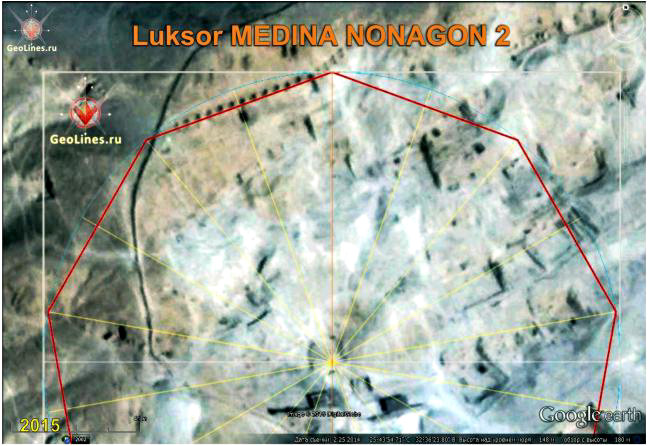
|
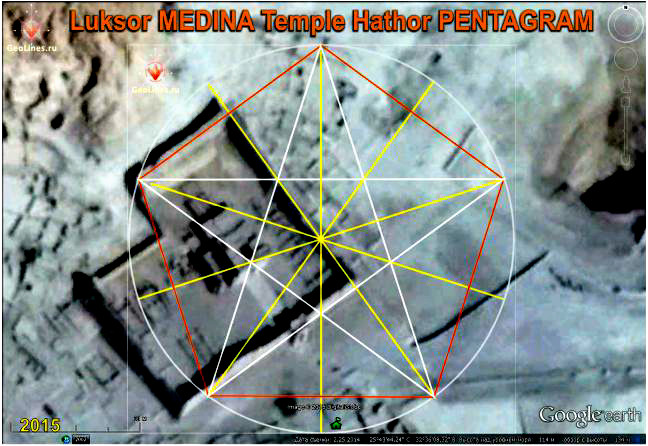 Temple of the goddess Nathor is designed and oriented according to pentagram, as well as some other churches, including Luxor. Temple of the goddess Nathor is designed and oriented according to pentagram, as well as some other churches, including Luxor. |
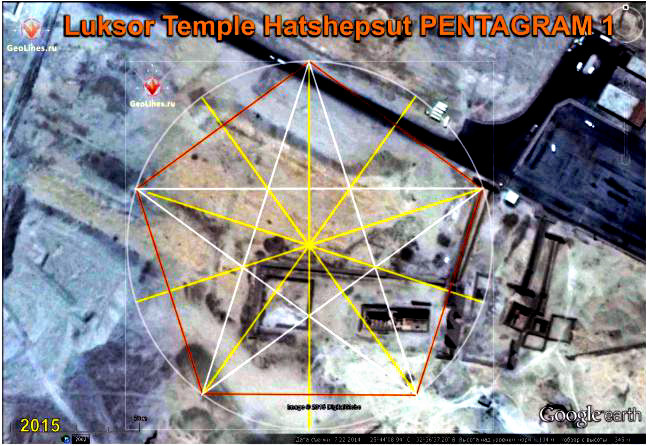 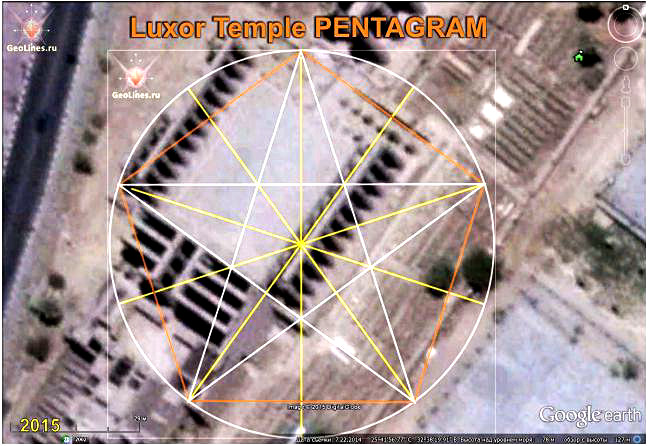 |
|
Temple of Osiris in Abydos was the main holy place for the ancient Egyptians to where pilgrimages were made from here according to the beliefs of the Egyptians souls of the dead were sent to the afterlife. It was connected with the legend that the goddess Isis found her husband’s head of Osiris, who was murdered by his brother Seth.
However, despite the fact that the temple is dedicated to Osiris at Abydos, many structures glorify The God Amun. It is believed that Osiris’s Temple was built by Pharaoh Seti I (1294 - 1279 BC). The complex has a complex structure and many premises. The temple was completed byRamses II, son of Seti I.
Orientation of the temple corresponds to pentagram and is close to the azimuth of 36°. Orientation of the neighboring church, which is less corresponds to the octagon, and is close to 45°.
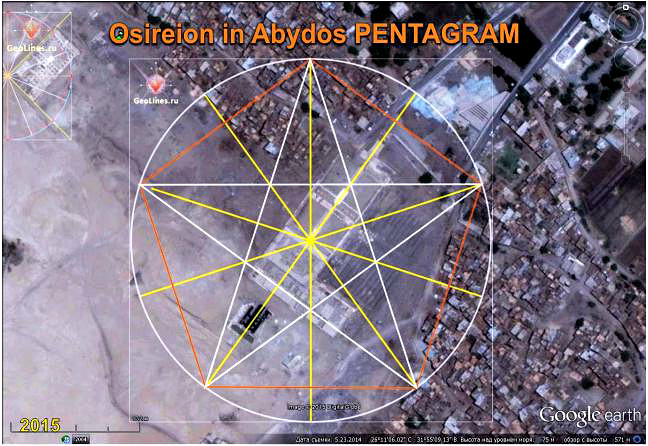 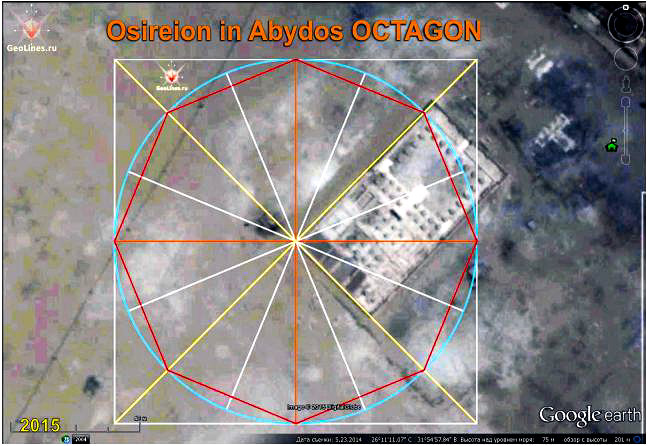 |
|
Surrounded with granite rocks a sacred island of the goddess Isis rushes with its columns and pillars to the blue sky. Philae Temple complex is one of three best-preserved "Ptolemaic" temples. The other two are in Dendera and Edfu. Fillet has about 400 meters in length and 135 meters in width.
The main walls of the temple are located at different angles to each other, but it is clearly seen that the east wall corresponds to the azimuth of 22.5°, i.e. half of octagon angle 45°.
The main facade of the temple is close to the azimuth of pentagram - 108°, as well as another one of walls.
|
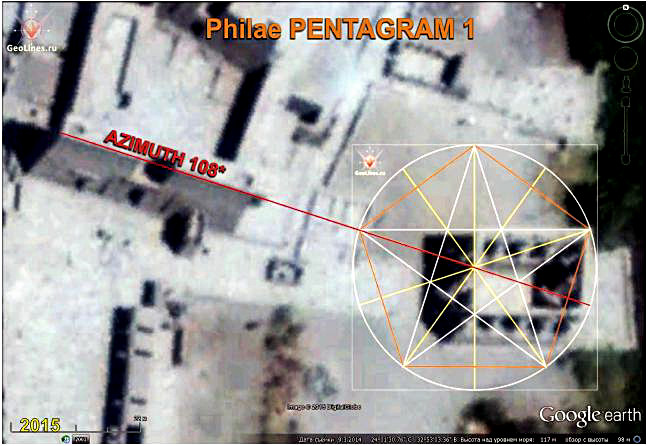 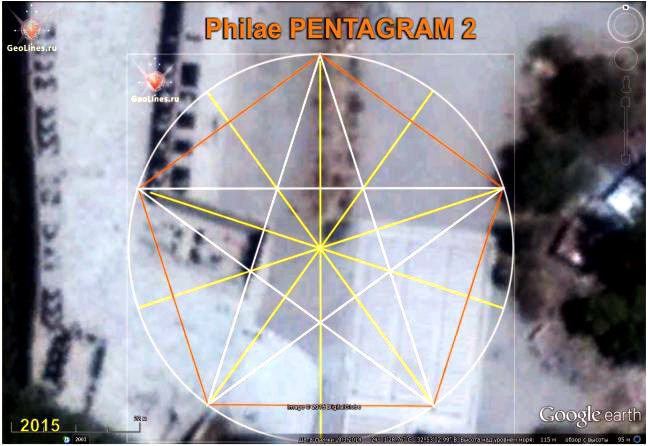 |
|
There is a small little-known temple in the desert, but with polygonal masonry and with famous tabs - "bosses". Azimut is 70°.
|
|
There is another little-known temple, which corresponds to the diagonal of pentagram.
|
|
In the south-east of the hill Sheikh Abd el-Qurna, on the crossroads of different cultural layers there are ruins of Ramesseum, "the temple of millions years" of Pharaoh Ramses II. In the first courtyard in front of the second pylon lies a broken colossus. This monument reached a height of 20 meters and weighed more than a thousand tons and fine work of stone carvers produces a truly unforgettable impression.
The temple is oriented along the azimuth of 135° and corresponds to octagon. |
|
In Yehe there is the oldest standing structure in Ethiopia: a tower built in the Sabaean style, it dates either VIII, or VII century BC. This tower gives to suggest some researchers that Yeha was the capital of the kingdom Daamot. Walls of early church survived. Among other ruins there is Grat Beal Gebre (Grat Beal Gebri) with square columns. The temple is oriented along the azimuth of 100° and corresponds to nonagon.
|
|
Temple of Horus in Edfu is built by Ptolemies in honor of the God Horus, and now is one of the best preserved Egyptian temple buildings. The temple was erected by Ptolemy III Euergetes in 327 BC. on place of more ancient temple of Tuthmosis III, built by Imhotep, the first priest-architect. Euergetes successors, until Cleopatra VII, the last queen of Egypt, continued the construction of this temple. Its structure is typical for Ptolemaic temples and is almost identical to the composition of the temple of Hathor in Dendera.
Temple of Horus is planned and oriented so that the diagonal of the small inner temple corresponds to the angle of pentagram - 36°.
.
|
|
The Reign Of Hatshepsut marked the unprecedented prosperity and the rise of Egypt. Of all the areas of her state activity Hatshepsut proved herself primarily as a pharaoh-builder. More than she built only Ramses II Meriamon. The queen restored a lot of destroyed monuments by Hyksos- invaders. In addition, she actively was engaged in the construction of temples.
The southern part inside of the temple has an azimuth of 108° and corresponds to pentagram. |
|
Medinet Habu is a huge architectural complex, the largest one after Karnak, is located in a place where for a long time there was a cult of Amun. What you can see today is only part of a huge complex which included, besides royal palace, warehouses, office buildings, buildings for the priests, an artificial lake with a channel through which the pharaohs could swim up to his dwelling, without touching the ground. These buildings, many of which are oriented at right angles, formed on the opposite from Thebes bank of the real city.
Diagonal of the big temple is close to the azimuth of 100° and corresponds to nonagon and smaller temple, situated in front of the main one is oriented according to pentagram.
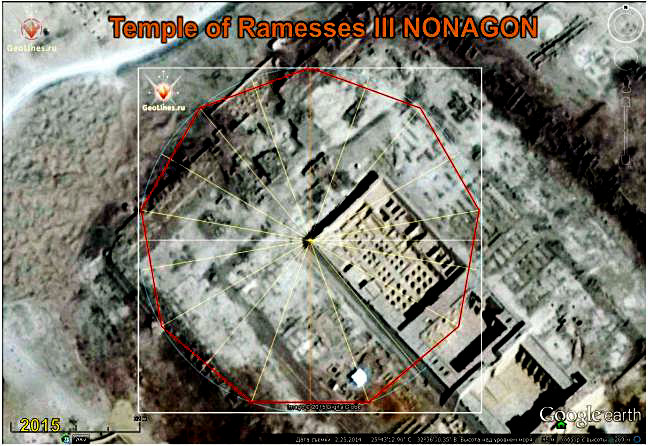 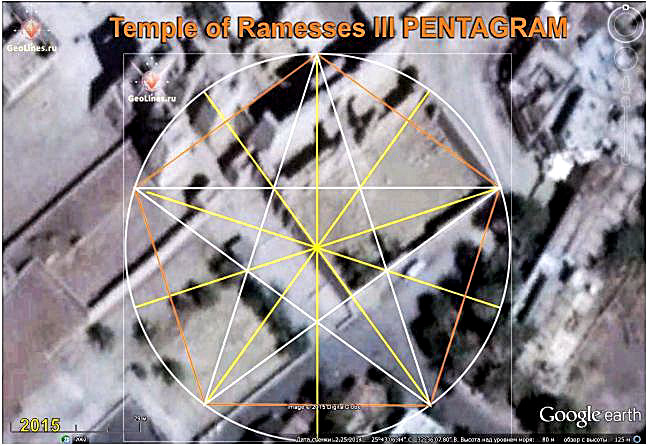
|
|
At the northern end of the Theban necropolis there is the Temple of Seti I. Seti I (1294-1279 BC) built a magnificent temple at Abydos decorated and great hypostyle hall in Karnak, he died before the completion of the memorial temple, so it was completed by son of Ramses II.
The temple and other buildings in the complex are oriented and designed according to pentagram.
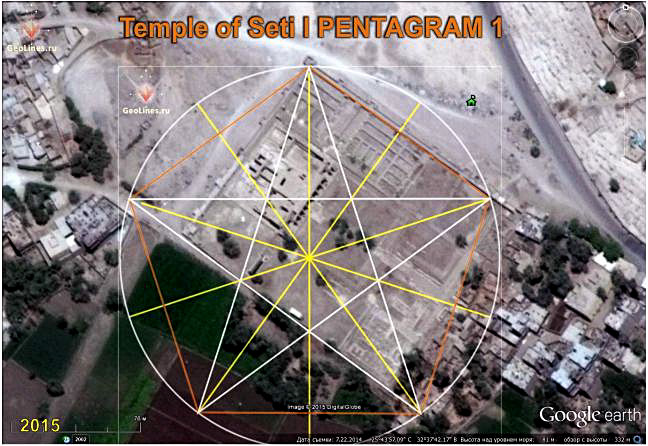 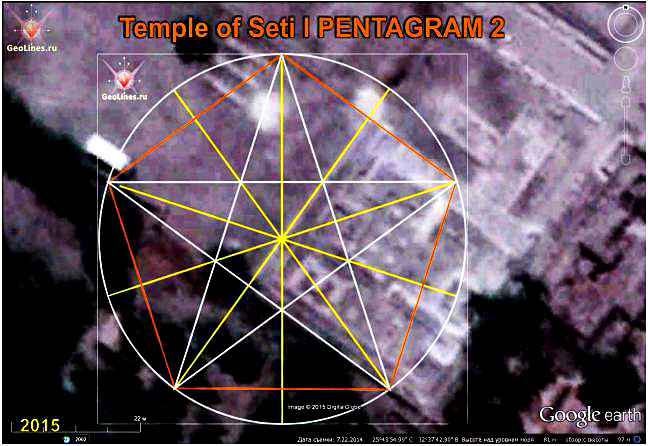
|
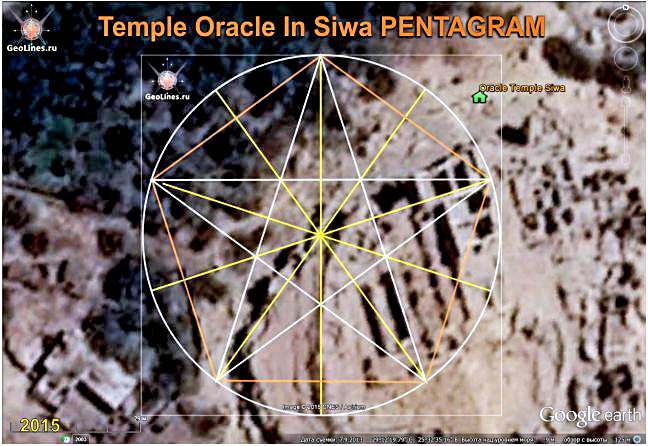
Temple of the Oracle at Siwa.
Siwa is ancient oasis -city in Egypt, the first mention of which dates back to the XXVI dynasty of pharaohs, when the necropolis was built. Siwa is related with Delphi, as there was another oracle. Before the conquest of Persia by Alexander the Great he visited Siwa, and according to legend, the oracle told him about his divine nature and called his a legitimate Pharaoh of Egypt.
Today, left a little from the Temple of Oracle but still it is clearly seen that the temple was oriented along the azimuth close to 162°, and its layout corresponds to pentagram.
|
|
A little-known temple, partly carved into the rock, has an orientation of 75° and corresponds to hexagram.
|
|
"Harbour in the desert" Ibn Khaldun called this an unusual settlement at the crossroads of five caravan routes by which were forwarded to the southern edge of the Sahara great treasures. In the Catalan Atlas of Charles V times the city was marked as the "Tenbuh", and in 1426 the Italian geographer Beccari reported about "Tumbettu" apparent wealth of which could be guessed in mosques with tall towers, decorated in gold palaces.
Famous mud mosque in Timbuktu is oriented along the azimuth of 80 degrees, which corresponds to a nonagon. |
|
Located on the Mediterranean coast, Tipasa was an ancient Punic trading point, captured by Romans and transformed into a strategic base for the conquest of the kingdoms of Mauritania. There is a unique group of Phoenician ruins, Roman, early Christian and Byzantine origin, as well as local monuments such as Kbor al-Rumia and great mausoleum of the kings of Mauritania.
The main group of Tipasa’s buildings is oriented according to hexagram along the azimuth of 60°. Another part of the structures, including an amphitheater is oriented along the direction of 75°, i.e. according to hexagram with rotation on 15 degrees. |
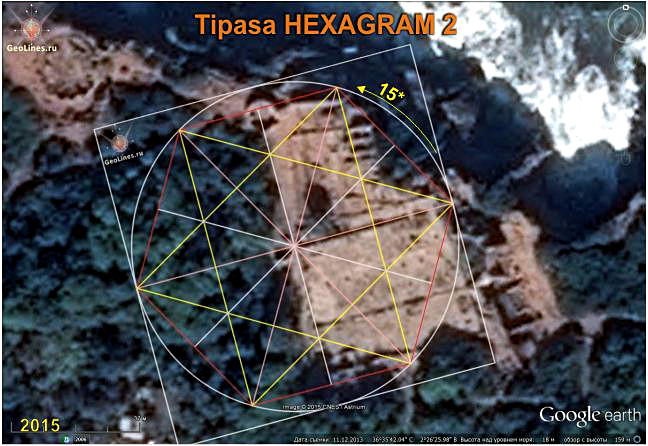 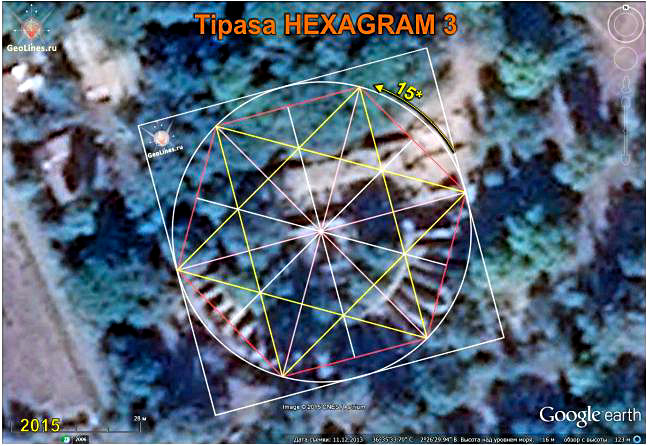 |
|
Tomb of Askia is wattle and daub building 17 m in height in the Malian city of Gao. It is buried Askia Mohamed I (1442-1538) in it the founder of powerful medieval state Songhai, the first ruler of the Sahel, who converted to Islam. It is the largest preserved pre-colonial building in the region.
The image clearly shows that at least one of the walls of the building is oriented along the azimuth 80° and corresponds to the angle of nonagon. |
|
Attractions of Morocco are the ruins of the ancient city of Volubilis, the most beautiful, largest and most grandiose Roman remains preserved in this country. The ancient city is situated near Meknes at Mount Zerhoun.
Once on this place was encampment of Stone Age people and then in the third century BC, made their settlement ancient Phoenicians here. Its very name of Volubilis is translated from Latin as "generosity." The city went into decline after a strong earthquake that devastated the aqueduct.
There are a lot of structures, which are oriented according to the angles of regular geometric shapes. |
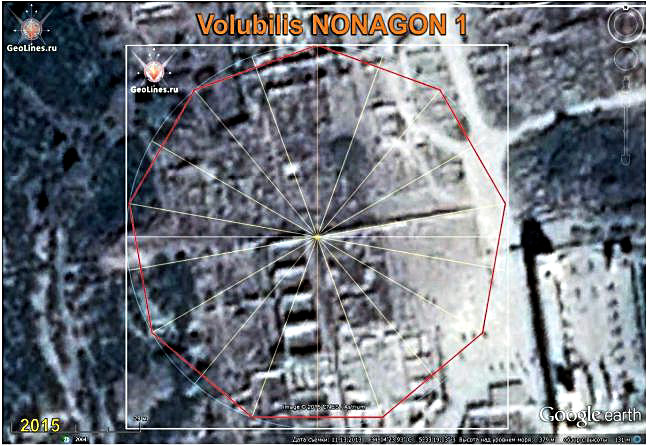  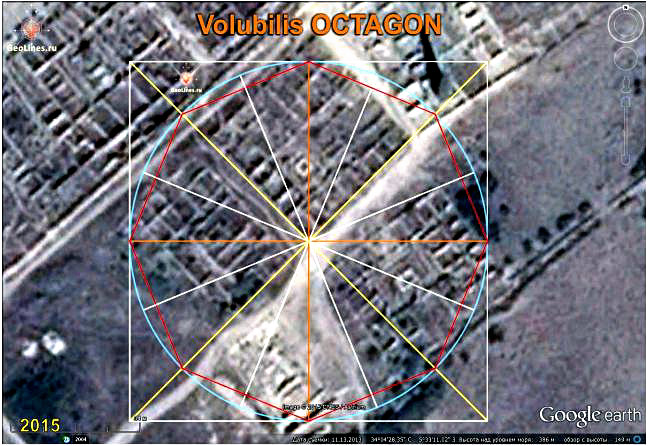 |
|
Stone circles over the graves were found in the Gambia and Senegal. They were built from the VIII to XII century on the burial places of an earlier time. Each ring is made of 10-24 bars of laterite in height of 100-250 cm. In total, we know at least 1,000 of these stone rings a special museum is dedicated to them. Although the purpose of these objects is controversial, UNESCO considered it possible to assign them to a World Heritage site.
There are the most famous two groups of such circles in which the largest number of stone pillars are concentrated. In the first group 4 circles mark the direction North-South and 5th is an angle 100°. The red line shows the direction to the second group of circles, the distance to which is 70 km 200 m. The azimuth of this line is exactly 270 degrees. Thus, two groups of circles give the line, which marks the direction West - East and specifies the scale. |
|
Recently, there are a lot of talk about the mysterious Yundum airport, which is located on the territory of a small African country of Gambia. Many researchers argue that the Airport is a legacy of ancient civilizations, which had aircraft - the so-called Vimana. Anyway, nobody knows by whom and when Yundum was built.
The fact that a modern airport, or rather its runway is built on the top of ancient stone slabs of great size. Where these plates come from, who put them and for what purpose no one knows. There were enough plates for a full-size runway, which can take any aircraft and they else remained. The image shows the area where the strip ends and continue only stone plates, which are laid along the azimuth of 130°.
|





